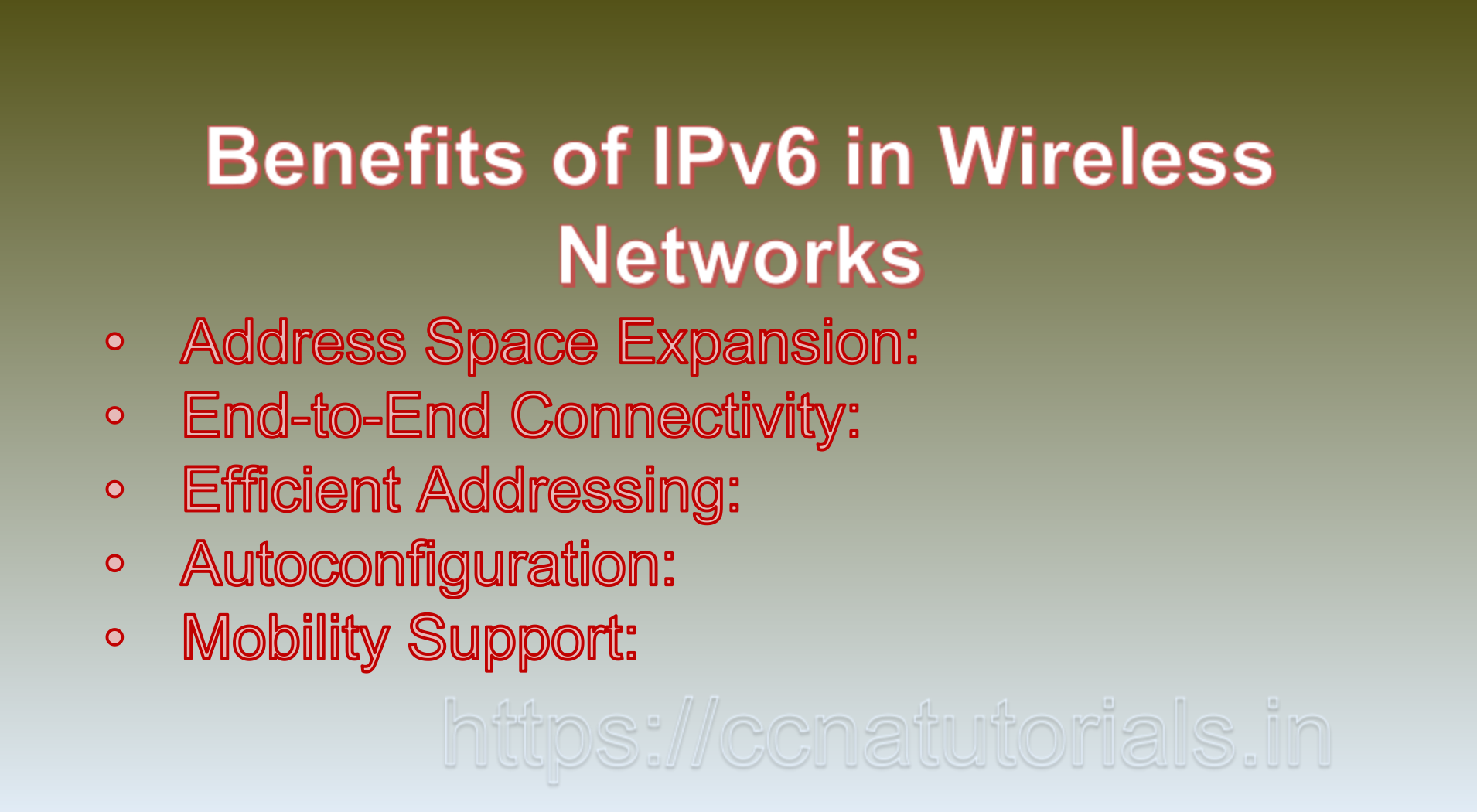Contents of this article
In this article, I describe IPv6 in Wireless Networks: Empowering Seamless Connectivity and Mobility. In the age of wireless communication, where smartphones, tablets, IoT devices, and more are integral to our daily lives, the role of IPv6 becomes paramount. IPv6, the sixth version of the Internet Protocol, has been designed to address the limitations of its predecessor, IPv4, and to accommodate the demands of modern wireless networks. In this article, we’ll delve into the significance of IPv6 in wireless networks, its benefits, implementation considerations, and provide examples to illustrate its importance in enabling seamless connectivity and mobility.
Understanding IPv6 in Wireless Networks: An Overview
Wireless networks have become ubiquitous, with Wi-Fi, cellular, and other wireless technologies connecting us to the internet and to each other. IPv6 plays a pivotal role in facilitating the communication between devices in these networks. With the proliferation of mobile devices and the Internet of Things (IoT), the need for unique IP addresses has grown exponentially. IPv6 addresses this demand with its vast address space, accommodating a virtually limitless number of devices.
Benefits of IPv6 in Wireless Networks
1. Address Space Expansion:
IPv6’s 128-bit address space provides an immense pool of unique addresses, ensuring that every wireless device can be assigned a globally unique IP address.
2. End-to-End Connectivity:
IPv6 encourages direct communication between devices, bypassing the need for Network Address Translation (NAT) and simplifying the process.
3. Efficient Addressing:
The hierarchical structure of IPv6 addresses enhances the efficiency of routing in wireless networks, improving performance and reducing latency.
4. Autoconfiguration:
Stateless Address Autoconfiguration (SLAAC) in IPv6 enables devices to configure their own addresses automatically, reducing the need for manual configuration.
5. Mobility Support:
IPv6 is designed to support mobile devices, allowing them to maintain their connections while moving between different networks.
Examples Illustrating IPv6 in Wireless Networks
1. Smartphones and Tablets:
Consider a smartphone connected to a Wi-Fi network using IPv6. As the user moves between different Wi-Fi networks or switches to cellular data, the smartphone seamlessly maintains its IPv6 connection. This mobility support ensures continuous communication without interruption.
2. IoT Devices:
IoT devices, such as smart thermostats or wearable fitness trackers, often connect to wireless networks using IPv6. These devices can send and receive data directly to and from the internet, allowing users to monitor and control them remotely.
3. Public Wi-Fi:
Public places like airports, coffee shops, and hotels often provide IPv6-enabled Wi-Fi networks. Users connecting to these networks can experience the benefits of IPv6, such as improved performance and end-to-end connectivity.
4. 5G Networks:
With the deployment of 5G networks, IPv6’s scalability and support for mobility become even more critical. The large number of connected devices and the need for low latency are well-suited to IPv6’s capabilities.
Implementation Considerations of IPv6 in Wireless Networks
1. Router Configuration:
Routers and access points in wireless networks must be configured to support IPv6. This includes enabling IPv6 routing, handling SLAAC, and managing the addressing scheme.
2. Device Compatibility:
While modern devices are generally IPv6-compatible, older devices may require updates or may not fully support IPv6. Ensuring compatibility across devices is crucial.
3. Security Measures:
Implementing security measures, such as firewalls and intrusion detection systems, becomes essential to protect IPv6-enabled wireless networks from cyber threats.
4. Network Management Tools:
Network administrators need suitable management tools to monitor, configure, and troubleshoot IPv6-enabled wireless network effectively.
IPv6 in the 5G Era: A Powerful Combination
The transition to 5G networks is revolutionizing wireless communication. With its ultra-low latency and high data rates, 5G will enable a new generation of applications and services. IPv6 complements these advancements by providing the necessary addressing and mobility support. The combination of IPv6 and 5G is a powerful force in shaping the future of wireless communication.
Short description of IPv6 in Wireless Networks
In the realm of wireless network, IPv6 is a game-changer. Its vast address space, end-to-end connectivity, efficient routing, and mobility support are critical components for modern wireless communication. Whether it’s a smartphone connected to a Wi-Fi hotspot, an IoT device communicating with cloud services, or the deployment of 5G networks, IPv6’s capabilities are essential for seamless connectivity, efficient data transmission, and the realization of a fully connected world. As wireless technology continues to advance, IPv6 will remain at the forefront of enabling cutting-edge applications and services in our wireless network.

IPv6 in Wireless Networks: Empowering the Next Generation of Mobile Connectivity
Wireless networks have become an integral part of our daily lives, connecting devices ranging from smartphones and tablets to IoT sensors and wearable devices. As these networks evolve to support the increasing demand for connectivity, IPv6 (Internet Protocol version 6) emerges as a fundamental enabler, addressing the challenges of addressing limitations, scalability, and enhanced capabilities. In this article, we will explore the role of IPv6 in wireless networks, its benefits, implementation considerations, and provide an example to illustrate its significance in the realm of mobile connectivity.
Understanding IPv6 in Wireless Networks: An Overview
IPv6 was introduced to overcome the limitations of its predecessor, IPv4, which faced address exhaustion due to the growing number of devices connected to the internet. In wireless networks, IPv6 serves as a key technology to ensure seamless and efficient communication between devices, regardless of their location or mobility. As more devices connect wirelessly and the Internet of Things (IoT) becomes ubiquitous, IPv6 addresses the need for a larger address space, improved end-to-end connectivity, and support for mobile devices.
Benefits of IPv6 in Wireless Networks
1. Abundant Address Space:
IPv6’s 128-bit address format provides an enormous number of unique addresses, ensuring that wireless networks can accommodate the rapidly growing number of devices and IoT sensors without running out of addresses.
2. End-to-End Connectivity:
IPv6 enables direct end-to-end communication between devices, eliminating the need for Network Address Translation (NAT) and simplifying network configurations.
3. Mobility Support:
IPv6 is designed to support mobile devices seamlessly. As devices move between wireless access points or networks, they can maintain their IPv6 addresses, allowing uninterrupted communication.
4. Autoconfiguration:
IPv6 incorporates features like Stateless Address Autoconfiguration (SLAAC), which simplifies the process of assigning addresses to devices, making it efficient for mobile and dynamic environments.
5. Quality of Service (QoS):
IPv6 introduces enhancements to Quality of Service mechanisms, ensuring that real-time applications like voice and video are prioritized for seamless communication.
IPv6 Implementation in Wireless Networks: Considerations
1. Address Assignment:
Wireless network must have a mechanism to assign IPv6 addresses to devices efficiently. Stateless Address Autoconfiguration (SLAAC) and Dynamic Host Configuration Protocol version 6 (DHCPv6) are commonly used methods.
2. Security:
As the number of connected devices increases, security becomes a critical concern. Proper security measures, including firewalls, encryption, and intrusion detection systems, must be implemented to protect wireless networks.
3. Mobile IPv6:
This extension of IPv6 enables seamless mobility for devices, allowing them to maintain their IP connections as they move between different wireless access points or networks.
4. Network Management:
IPv6-enabled wireless networks require network management tools that support IPv6 features, including address management, traffic monitoring, and security configuration.
Example Illustrating IPv6 in Wireless Networks
Consider a scenario involving a user with a smartphone in an IPv6-enabled wireless network:
1. Address Assignment:
The smartphone connects to the wireless network, and through SLAAC or DHCPv6, it is assigned a unique IPv6 address. This address can be used to identify the device within the network.
2. End-to-End Communication:
The user accesses a streaming video service on their smartphone. The smartphone communicates directly with the video server using its IPv6 address, establishing an end-to-end connection without the need for address translation.
3. Mobility Support:
As the user moves around, the smartphone connects to different wireless access points. Its IPv6 address remains constant, allowing ongoing communication without interruption.
4. IoT Integration:
In the same network, IoT sensors are also connected, each with its unique IPv6 address. These sensors can send data directly to the cloud or other devices using IPv6, facilitating real-time monitoring and data analysis.
Conclusion for IPv6 in Wireless Networks
IPv6 plays a pivotal role in the evolution of wireless networks, supporting the demands of mobile connectivity, IoT, and the increasing number of connected devices. Its abundant address space, support for end-to-end communication, mobility features, and efficient autoconfiguration make it a crucial technology for ensuring seamless and scalable wireless connectivity. As wireless networks continue to expand and shape the digital landscape, IPv6 provides the foundation for enabling innovative applications and services that rely on robust and flexible mobile communication. You may comment below or contact us for any query related to this article.






